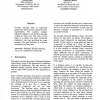34 search results - page 2 / 7 » Cardinality, Counting, and Equinumerosity |
IWPEC
2009
Springer
14 years 2 months ago
2009
Springer
Abstract. We show that the partitions of an n-element set into k members of a given set family can be counted in time O((2− )n ), where > 0 depends only on the maximum size am...
EUSFLAT
2001
13 years 9 months ago
2001
Flexible querying aims at expressing preferences inside queries instead of strict requirements. We consider ordinary relational databases and flexible querying calling on fuzzy se...
ASIACRYPT
1999
Springer
13 years 12 months ago
1999
Springer
Abstract. A prohibitive barrier faced by elliptic curve users is the difficulty of computing the curves’ cardinalities. Despite recent theoretical breakthroughs, point counting ...
INFOCOM
2009
IEEE
14 years 2 months ago
2009
IEEE
—The Internet host cardinality, defined as the number of distinct peers that an Internet host communicates with, is an important metric for profiling Internet hosts. Some examp...
PERCOM
2008
ACM
14 years 7 months ago
2008
ACM
Counting or estimating the number of tags is crucial for large-scale RFID systems. The use of multiple readers was recently proposed to improve the efficiency and effectiveness in ...

